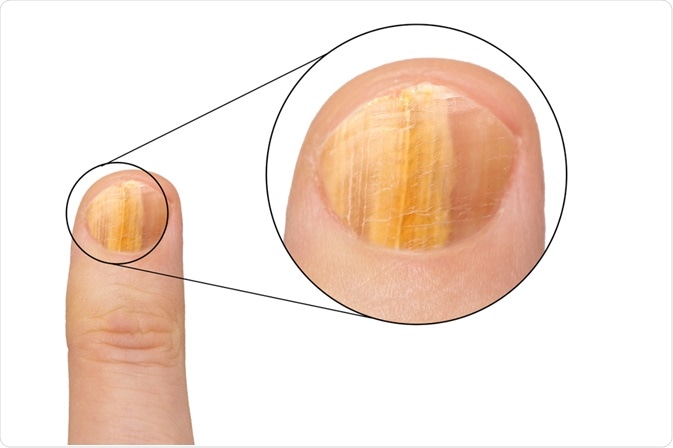Onychomycosis is a condition that may be caused by a number of potential pathogens. These can be categorized into three general classes of dermotophytes, Candida, and nondermatophytic molds.
In temperate western countries, the fungi that is most commonly responsible for causing this condition are dermatophytes. In areas with a hot and humid climate, however, such as in the tropics and subtropics, Candida and nondermatophytic molds are more frequently involved as the cause of infection.

Image Credit: sruilk / Shutterstock.com
Dermatophytes
There are several dermatophytes that may be responsible for causing onychomycosis, although the most common is Trichophyton rubrum. In addition to this, other dermatophytes that may play a role in some individuals include:
- Trichophyton interdigitale
- Epidermophyton floccosum
- Trichophyton violaceum
- Microsporum gypseum
- Trichophyton tonsurans
- Trichophyton soudanese
Medical laboratories occasionally refer to Trichophyton mentagrophytes as Trichophyton interdigitale, although this is outdated terminology and should be restricted to the favus skin infection agent in mice. This fungus can be transmitted to humans via mice and their excrement, although it usually produces a skin infection rather than affecting the nails.
Candida albicans
Candida albicans is primarily responsible for causing onychomycosis of the fingernail. This specific type of infection occurs most commonly in people whose hands are often submerged in water, such as swimmers and divers.
The infection usually affects the soft tissue surrounding the nails initially and then continues to cause a secondary infection to the nail plate.
Nondermatophytic molds
The mold generations that are most frequently known to lead to nail fungus are Scytalidium, which is also known as Neoscytalidium, Scopulariopsis, and Aspergillus.
In tropical and subtropical climates, Scyalidium is a common cause of onychomycosis and affects a large number of people. In addition, this infection is known to persist without treatment, even if affected individuals later relocate to areas with a more temperate climate.
Nondermatophytic molds are more likely to affect elderly people that are at least 60 years of age. This is often a result of a slight weakening in the nails' ability to fight off infection, predisposing them to the condition.
Risk factors
Whilst not directly causing onychomycosis, there are several factors that are associated with a higher risk of suffering from the condition.
Age is a strong risk factor for onychomycosis. This is thought to be due to decreased blood circulation and weakening of the nail’s defense against fungal infection and its ability to protect itself. In addition, elderly people’s nails tend to grow more slowly and are often thicker than the nails of people in the general population. Finally, it is likely that people of advanced age are more likely to be affected, as they have been exposed to the fungi for a longer period of time.
Exposure to moist environments can also increase the probability that an individual will be affected by the conditions. This includes humid temperatures, as well as heavy perspiration that is secreted directly onto individuals' skin.
Restricted ventilation to the area can also lead to a risk of infection. This is particularly common for toenails when individuals wear socks and shoes that do not allow the feet to breathe and often store perspiration to create a moist environment.
Additionally, the fungus can also be transmitted among humans that are affected. Neglecting to wear shoes in public places where contact with the fungus may occur such as swimming centers, gyms, and shower rooms is likely to increase the chance of infection.
Finally, some existing health conditions are associated with a higher risk of onychomycosis. These include psoriasis, athlete’s foot, which is also known as tinea pedis, damage to nails, diabetes, circulation problems, and a weak immune system.
Further Reading
Last Updated: Apr 13, 2021